| Home > Policy > White Paper, Notice, Announcement > White Paper > JAPANESE GOVERNMENT POLICES IN EDUCATION, SCIENCE, SPORTS AND CULTURE 1997 > Scientific Research Chapter 2 Section 1 2 | ||
According to the Survey of Research and Development conducted by the Management and Coordination Agency, total research funds in Japan, including the humanities and social sciences, reached \14,408.2 billion in fiscal 1995. Companies accounted for \9,395.9 billion, or 65.2%, of this total, and universities (including inter-university research institutes, junior colleges, and colleges of technology) for \2,982.2 billion, or 20.7%. Total research funding in Japan has increased approximately 1.6 times in the 10 years since 1986, when it was \9,192.9 billion. There has, however, been no significant shift in the share of the total that is spent by each type of research organization ( Figure 2-6 ).
In fiscal 1995, public funds accounted for 22.9% of total research funds in Japan. This figure, the highest in the past 10 years, represents an increase of 1.4 percentage points compared with fiscal 1994 ( Table 2-5 ).
Analysis of the characteristics of research funds (whether for basic and applied research or development * ) in each type of organization shows that universities devote 53.0% to basic research, whereas research institutes and companies spend 54.4% and 71.3%, respectively, on development ( Figure 2-7 ). These figures indicate that universities give priority to basic and applied research, whereas research institutes and companies focus mainly on applied and development research geared to the practical implementation of technology and the development of commercial products.
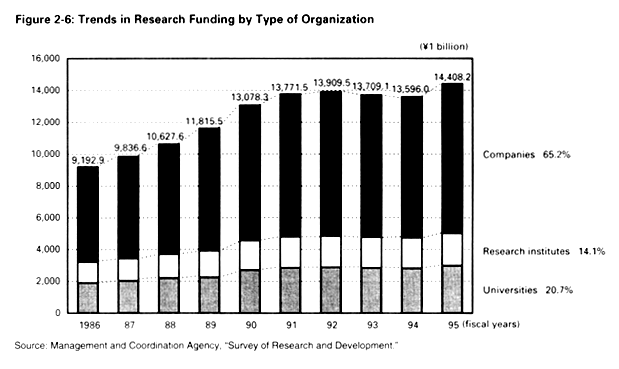
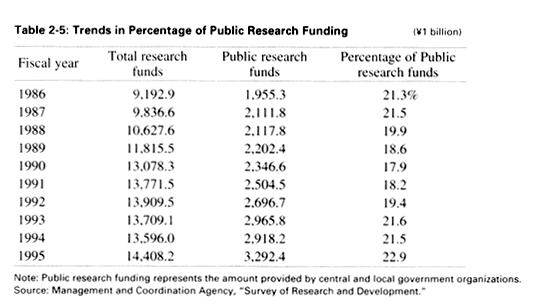
* The Management and Coordination Agency's "Survey of Research and Development" defines these terms as follows:
Basic research
: Theoretical or experimental research undertaken for the formulation of hypotheses and theories, or for the acquisition of new knowledge, without any particular application or use in view.
Applied research
: Research undertaken in order to determine possible uses of basic research with a specific practical aim or objective, or to explore a new form of application different from those that exist.
Development
: The use of results gained from basic and applied research, or practical experience, that is directed to the introduction of new materials, equipment, products, systems, and processes, as well as to the improvement of those already introduced.
An analysis of science and technology expenditure in the overall government budget reveals that research-related expenditure in Japan will total \3,002,8 billion in fiscal 1997. Of this, MESSC will account for \1,289.0 billion, or 42.9%, the Science and Technology Agency for 24.5%, and MITI for 15.7% ( Figure 2-8 ).
Funds for science and technology are provided by the allocation for science and technology in the general and special accounts. The MESSC general account has an appropriation of \324.1 billion, including \112.2 billion for grants-in-aid for scientific research, \39 billion for grants and investments by JSPS, \1,9 billion for local public universities, and \156.0 billion for private universities. The special account provides \964.8 billion for national universities including personnel salaries, unit cost per professor, and facility improvement costs ( Figure 2-9 ).
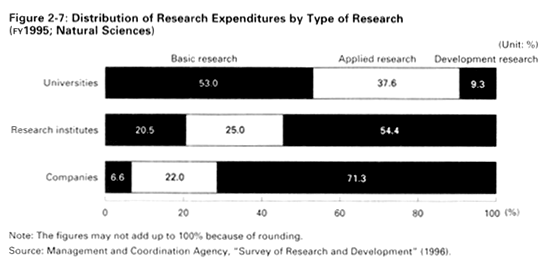
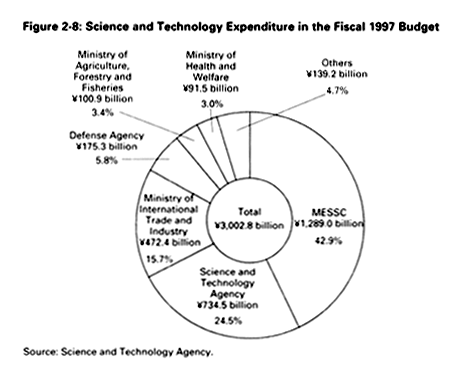
Funding for national universities is provided through the special account for national educational institutions, which is separate from the general account. This special account plays an important role not only in financing personnel salaries and the costs of day-to-day research in national universities and inter-university research institutes, but also in providing and improving all of the conditions necessary for education and research, including facilities and equipment.
Funding for local public and private universities is provided from the general account, reflecting the important function fulfilled by these institutions.
In the Science and Technology Basic Plan, research funds are divided into competitive funds, priority funds, and basic funds. The following discussion explains that portion of the MESSC research budget that bears on universities in terms of these categories.
Competitive funds are allocated selectively to researchers or research groups on the basis of appropriate screening and evaluation. MESSC programs in this category include grants-in-aid for scientific research and research expenses provided under the Research for the Future Program. The Science and Technology Basic Plan calls for a substantial increase in these types of funding, and in view of their importance, MESSC has significantly increased its budget for grants-in-aid for scientific research.
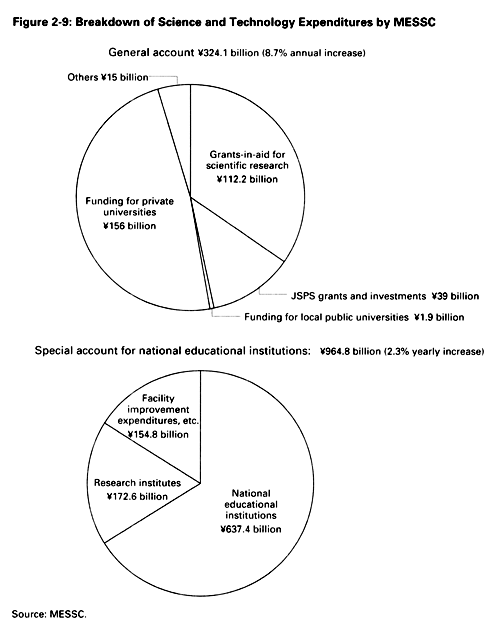
(a) Grants-in-aid for scientific research
: Grants-in-aid for scientific research promote scientific research in Japan by stimulating appreciable progress in creative and pioneering research in all fields from the humanities and social sciences to the natural sciences. Grants are awarded to projects planned by individual researchers or research groups that involve particularly important basic research that is in keeping with current trends in scientific research ( Table 2-6 ).
A budget of \112.2 billion has been allocated in fiscal 1997. As is apparent from trends in the budget ( Figure 2-10 ), MESSC regards this as one of its most important programs for promoting scientific research. The high level of interest and anticipation with respect to these grants is apparent from Figure 2-11 , which traces application and acceptance trends. In 1996 three out of five university researchers applied for grants. Grants-in-aid for scientific research are allocated on the basis of impartial screening by the Science Council. MESSC recognizes the importance of grants-in-aid for scientific research and is working to increase the amount provided as well as to promote systemic improvements and the disclosure of information ( Table 2-7 ).
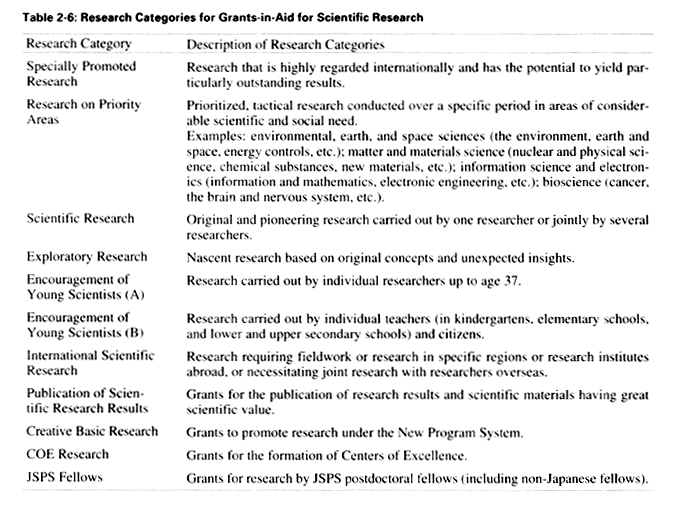
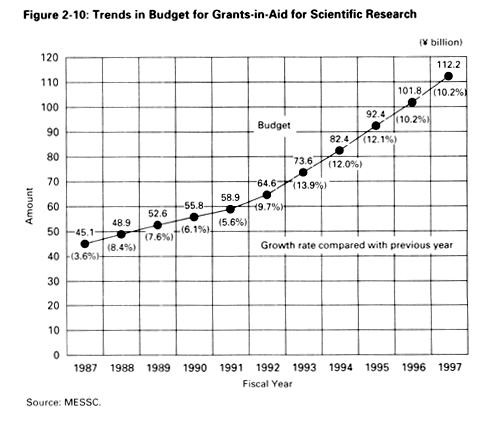
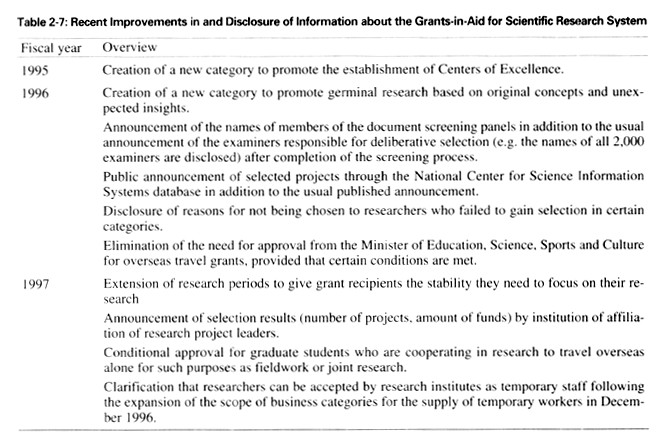
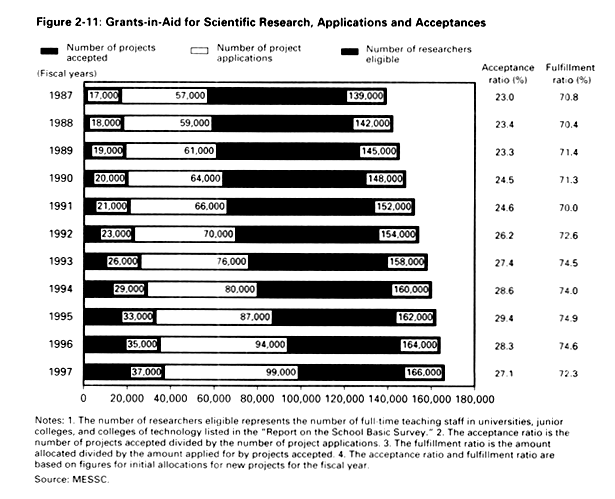
Screening and Allocation Procedures for Grants-in-Aid for Scientific Research Screening Mechanism Applications are screened by the Committee on Grants-in-Aid for Scientific Research of the Science Council, which advises the Minister of Education, Science, Sports and Culture. The committee consists of approximately 2.000 examiners (formally referred to as "committee members" or "expert committee members" of the Science Council) covering all disciplines from the humanities and social sciences to the natural sciences. Projects planned independently by researchers are screened by the examiners on the basis of publicized criteria that include originality, level of scholastic contribution, and suitability of the research organization. Grants are allocated on the basis of this screening process. Screening Method There were nearly 100,000 applications for FY 1997 grants. The majority of these were either selected or rejected on the basis of the following two-stage process. Stage 1 : Documentary screening of all research projects by 3-6 (or more) examiners. More accurate evaluation Stage 2 : All committee members split into specialized subcommittees (8-35 members) for each field to deliberate selection on the basis of results from the first stage and other information. In categories that involve the allocation of large research grants, decisions are based on direct interviews with applicants. Examiners The examiners are leading researchers representing academic societies and other organizations in Japan. In some categories, they also include researchers and other qualified persons from the private sector. Examiners are selected with the help of the Science Council of Japan. The nature of the task makes it extremely important that screening be carried out impartially. For this reason, the term of office is, in principle, strictly limited to one two-year period. Since 1996 the names of all examiners have been publicized after the completion of the screening process out of consideration for public access to information about it. |
(b) Research for the Future Program
: Japan aims to establish a nation based on the creativity of science and technology in the 21st century. An active commitment to highly creative scientific research is vital to realize goals that include solutions of global problems, socioeconomic development, and the enhancement of the quality of life. In FY 1996, a new system was created to provide funds to JSPS, which is implementing the Research for the Future Pro-gram, which promotes future-oriented and highly creative research with the potential to create intellectual assets in selected fields.
Under this program, applied scientific research is conducted by the JSPS itself or is commissioned to universities or research institutions, where researchers are playing a central role in research designed to meet the needs of society. When necessary, the cooperation of industry and other sectors is sought for this university-led research. To accelerate research efforts and contribute to the training of young researchers, postdoctoral researchers are encouraged to participate in projects as JSPS research associates.
The Research for the Future Program Committee, made up of leading Japanese researchers, was established within JSPS to manage the program. The committee selects priority fields and projects on the basis of Science Council recommendations and of the results of research supported by grants-in-aid for scientific research and other types of funds. Research promotion committees, made up of top researchers, have been established for each field to plan and propose research projects and provide guidance and advice to research project teams. In addition, the Committee for Research Promotion in Specialized Areas and the University-Industry Cooperative Research Committee, which were established to promote cooperation and coordination relating to science among various sectors of society, are also providing guidance and advice about the planning and proposal of research projects.
In principle, research projects will last for five years. An interim evaluation will be carried out two years after the start of each project, however, and some may be discontinued at that stage. Final (post-project) evaluations will be made at the end of five years.
The average annual funding per project is about \100 million, In fiscal 1997 nine additional research fields and 87 new projects were selected, bringing the total number of new and continuing projects to 204 in 26 fields. There are 11 physical and engineering sciences, including exploratory research on novel artificial materials and substances for next-generation industries, innovation in energy generation, conversion, materials and systems for the future and computational science; nine fields from life sciences, including higher brain functions, infectious diseases and bioregulations, and genetic and environmental factors in diseases prevalent in adults and the elderly; and six fields from integrated disciplines including information life systems, causes and effects of environmental loads, and environmental conservation in the Asian region.
Seven government ministries and agencies, including the MESSC, the Science and Technology Agency, the Ministry of Agriculture, Forestry and Fisheries, the Ministry of Health and Welfare, the Ministry of International Trade and Industry (MITI), the Ministry of Transport, and the Ministry of Posts and Telecommunications, are implementing basic research promotion programs utilizing investments in special corporations. Around \56.9 billion was budgeted for this purpose in fiscal 1997, an increase of about \24.8 billion over the previous year. Universities and affiliated research institutions win most of these various types of competitive funding.
Priority funds are provided for research and development of national importance, such as big science and project research. Items In MESSC's budget that fall into this category include funds for the prioritized promotion of basic research. The Science and Technology Basic Plan calls for expanding funds of this type, which is essential to promote diversified research and development, along with increases in competitive funds.
![]() Promotion of basic research in selected areas: Taking into account current research trends in Japan and abroad, MESSC actively promotes fields of basic research that require an organized and international approach, that are the focus of very strong social needs, or that require relatively large expenditures for large-scale facilities and equipment. The main research fields selected by MESSC for prioritized promotion are listed in the following table .
Promotion of basic research in selected areas: Taking into account current research trends in Japan and abroad, MESSC actively promotes fields of basic research that require an organized and international approach, that are the focus of very strong social needs, or that require relatively large expenditures for large-scale facilities and equipment. The main research fields selected by MESSC for prioritized promotion are listed in the following table .
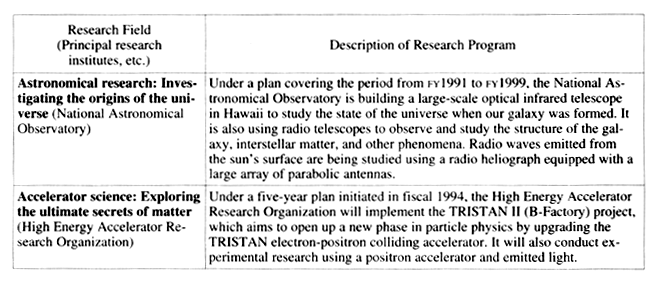
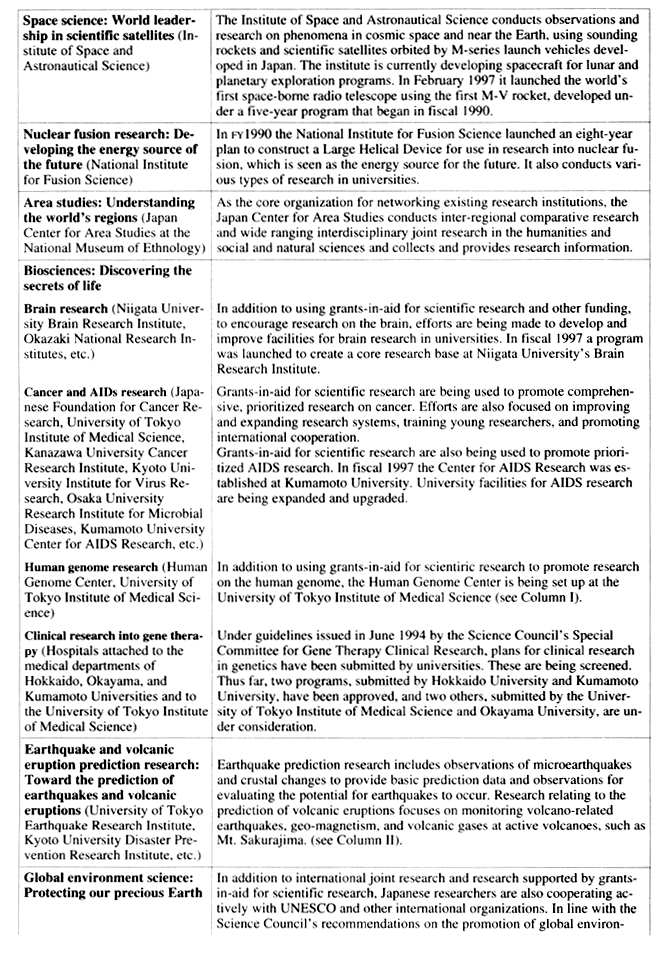
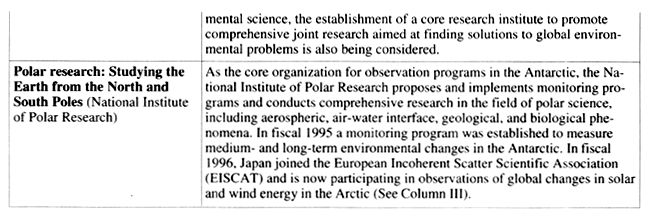
Column 1: Human Genome Research in Universities and Affiliated Research Institutes 1. Promotion of the Human Genome Program "Recommendations Concerning the Promotion of the Human Genome Program in Universities" (Science Council. July 1989) Phase I (establishment): Five years, from fiscal 199 1 to fiscal 1995 "Five-Year Plan to Promote the Human Genome Program in Universities" (Report of the Science Council Bioscience Subcommittee, July 1990) * Recommendations concerning promotion of research in the initial five-year period: establishment of a human genome center, promotion of group research, etc.
Phase II (Development): Five years, from FY1996 to FY2000 "Toward the Promotion of Human Genome Programs in Universities: Phase II (Development)" (Report of the Science Council Bioscience Subcommittee, April 1995)
2. Development of a DNA Databank "Development of a DNA Databank" (Report of the Science Council Bioscience Subcommittee, July 1994) * Various government organizations will jointly establish DNA Database of Japan (DDBJ) within the National Institute of Genetics to serve as a domestic base for research in this field. |
Column II: Review of Earthquake and Volcanic Eruption Prediction Programs by the Geodesy Council At the June 1997 general meeting of the Geodesy Council, the Earthquake and Volcano Subcommittee presented the two reports summarized below. (1) "Review of the Implementation of Earthquake Prediction Plans" Over 30 years have passed since the Earthquake Prediction Plan was launched in 1965. In the wake of the Great Hanshin-Awaji Earthquake, which inflicted massive damage in the southern part of Hyogo Prefecture in January 1995, however, a number of changes have occurred in the situation surrounding the plan, including the establishment of the Earthquake Disaster Prevention Special Measures Act. It was apparent from these developments that the time had come for a review of the Earthquake Prediction Plan, and activities over the 30 years since the establishment of the initial plan were therefore reassessed. The review covered aspects of earthquakes that have come to light as a result of the Earthquake Prediction Plan and the extent to which targets have been met. The report concluded that it is generally impossible at present to predict the time, location, and intensity of earthquakes with sufficient accuracy to justify issuing warnings, but that it will be possible to predict an earthquake in the Tokai region if phenomena similar to precursors that occurred in the past are observed. As to the future of the Earthquake Prediction Plan, the report stated that the plan should go beyond its traditional emphasis on monitoring and research targeting the discovery and investigation of individual abnormal phenomena and surveys of intervals between recurring major earthquakes. It highlighted the need for monitoring and research that focuses on identifying imbalances in strength patterns within the crust that would facilitate a constant grasp of stresses and distortions. (2) "Review of the Implementation of the Volcanic Eruption Plan" The disaster caused by pyroclastic flows on Mount Unzen Fugen-dake has caused changes in the information about volcanoes that is demanded by the public. Japan instituted its first Volcanic Eruption Prediction Plan in 1974 and is now into its fifth plan. At this juncture, it was decided to review overall implementation since the first plan to identify issues and prospects for the future. The report states that the observation process has been enhanced by the development of wide-area, high-grade, high-density, multi-faceted monitoring methods, and that it is now generally possible to detect eruption precursors on a number of active volcanoes through intensive, comprehensive monitoring. With regard to the future of the Volcanic Eruption Prediction Plan, the report states that the development of practical prediction systems will require an understanding of the mechanism whereby eruptions and eruption precursors occur. It also stressed the importance of a four-dimensional understanding of volcanic structures, including the time axis, based on monitoring the behavior of magma, volcanic gases, and other fluids, and changes in subterranean conditions. |
Basic funds are applied to the ordinary research funds and costs of operating research facilities and equipment that enable researchers to undertake fundamental research activities steadily and effectively. The leading example of this type of funding in the MESSC budget is the unit cost per professor in national universities. The Science and Technology Basic Plan calls for an increase in funds of this type.
Unit cost per professor
: Funds in this category pay for purchasing the materials and equipment needed by faculty to instruct students and conduct research, as well as the cost of utilities. Calculated on the basis of the number of faculty members, these allotments provide for the expenses essential to maintaining educational and research activities in the national universities. The amount of funding has been increasing steadily over the years and was around \154.1 billion in fiscal l997.
Subsidies are also provided for regular expenditures required for education and research in private institutions of higher education. In the FY 1997 budget, provision for general subsidies, which are allocated according to the number of faculty and students, is about \228.2 billion.
In FY1996 a questionnaire survey on the research environment for university researchers ("Research Environment Survey") was conducted to investigate questions relating to grants-in-aid for scientific research. The survey was sent to some 8,400 university researchers, of whom 4,994 responded, a ratio of about 60%. Results for the main items relating to research costs are outlined below.
(a) Overview of individual research costs
: The survey asked about the sources of individual researchers' funds in fiscal 1995. This question referred to research funds used by individual researchers; overhead costs, such as facility maintenance and operating costs and utility charges, and costs relating to the education of students were excluded. The results are shown in Table 2-8 .
Analysis of the sources of research funds shows. that fundamental funds allocated by university authorities accounted for 34.1% of total funds, grants-in-aid for scientific research for 27.9%, private sector firms for 14.8%, government ministries and agencies (other than MESSC) and special corporations for 12.1 %, and research-grant foundations and local government organizations for 11.0%.
Figures by field show that researchers in the humanities and social sciences relied heavily on funds allocated by university authorities, which accounted for 60.0% of total funding. This ratio was 29,1% for those in the natural sciences and 45.6% in multidisciplinary fields, indicating that sources of funds are comparatively diverse in these fields.
The breakdown of types of expenditure in Table 2-9 reveals significant differences between those in the humanities and social sciences and those in the natural sciences and multidisciplinary fields. In the former category, books and domestic travel accounted for a large share of expenditure (about 46% overall), while in the latter category, the percentage of funds spent on facilities, equipment, and expendable supplies was extremely high at around 80% of the total. Areas in which funding shortages were particularly acute (in order of response frequency) were: books, facilities and equipment, and domestic travel for those in the humanities and social sciences; facilities and equipment, supplies, and domestic travel for those in the natural sciences; and facilities and equipment, domestic travel, and supplies for those in multidisciplinary fields. ( Figure 2-12 ).
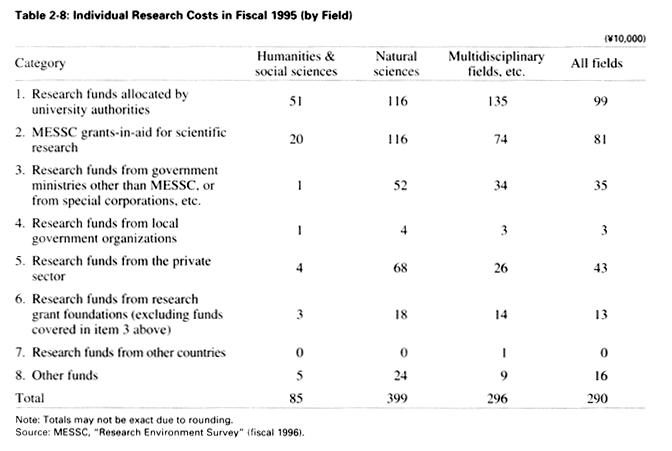
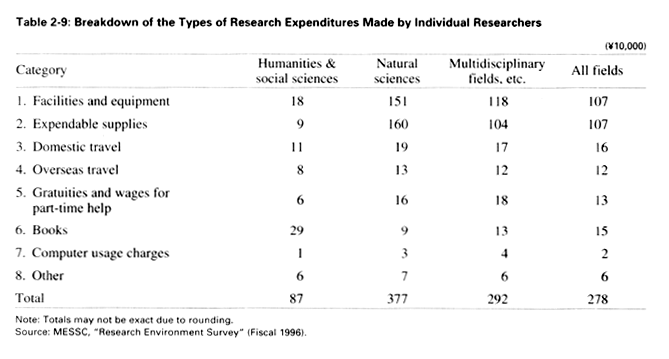
(b) Effective means of improving research funding
: Survey participants were asked to consider means of improving research funding, including not only increases in government outlays, but also the diversification of funding sources and self-help efforts by universities. The most frequent response, selected by around 60% of respondents in all fields, was "promote funding from research grant foundations." The next most common choice, "promote funding from private sector companies," received an overall response ratio of 42.6%, but there was considerable variation in the percentages by field, ranging from 26.9% in the humanities and social sciences to 52.0% in the natural sciences ( Table 2-10 ).
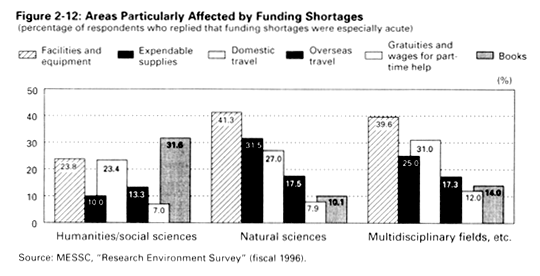
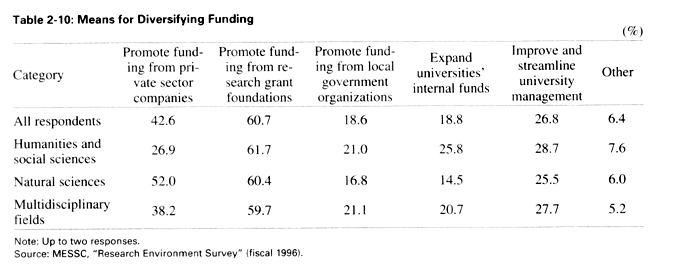
| Back to Top | MEXT HOME |